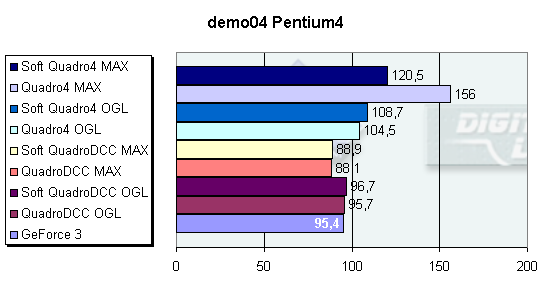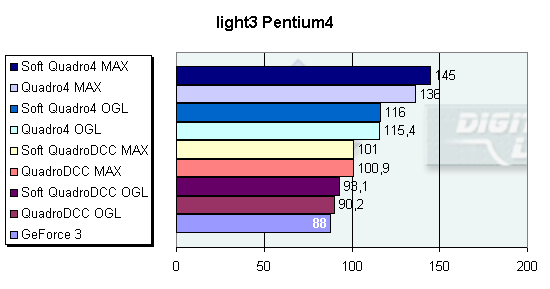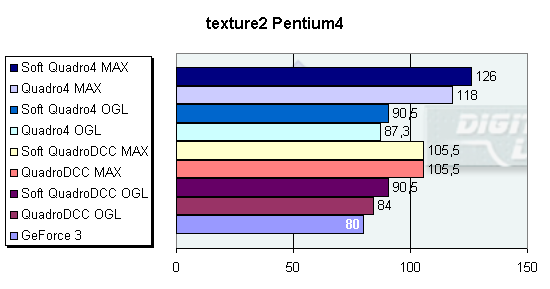 |
||
|
||
| ||
Operation of the Quadro cards with the SoftQuadro II mini driver.Through the Network we often get information on redesigning of production game cards based on the NVIDIA GeForce chips, in particular, into professional accelerators. In fact, there are series of game cards and professional accelerators based on a single NVIDIA's chip. And a lot of enthusiasts, thus, remake their game cards into professional ones using different methods, from changing drivers to resoldering the card trying to get a benefit both in price and in performance in professional applications. Well, if the cards are based on the same chip, what prevents a user from installation of new drivers or resoldering the card, except a lost warranty? Nothing prevents, and there are a lot of users who do it. In this case the company bears losses. But do the users get a performance boost, or only the price benefit? Of course, the aim is to get the performance gain. However, both factors affect the result. Let's assume a designer has bought a game card and remade it into a professional one; as a result, he obtained good performance comparable to that of professional models and saved money. He is satisfied, and the manufacturer incurs losses. But what if it's not just a single designer but a design studio? Undoubtedly, a manufacturer will fight with such actions. Well, it is for you to decide whether to remake a game card into a professional one or not; and today I will just show you advantages and disadvantages of this approach. Well, one of the methods to redesign the card is to use a special driver written by the author of the best utility for operation with NVIDIA's cards - RivaTuner. I admit there are a lot of such utilities, and if it's possible I will examine their operation, but today we will take a look at the SoftQuadro driver. It works on the driver level, i.e. you don't need to resolder the PCB. After installation of the SoftQuadro based on the official drivers of v28.32 the GeForce3 turns into Quadro DCC, and GeForce4 4600 into Quadro4 900XGL. Settings in Display Properties inform about a game accelerator, but the additional tabs notify about professional ones. Nevertheless, I must note that special settings don't work in applications. For the tests I've chosen the 3D Studio MAX 4.26 as the most optimal tool. The tests were carried out under the OpenGL API and MAXTreme driver. As you know, the MAXTreme driver doesn't work with game cards. But it does work with the SoftQuadro cards (let's call them this way). I carried out not only qualitative tests, but also emulated a real designer's work. I must note that it's very difficult to draw a distinction between the professional and game accelerators and the obtained ones. We have already written about it. That is why I turn directly to the quantitative tests. The most interesting thing starts here. This process resembles cloning of living organisms. It seems that everything was done correctly and the organism must live. But it dies. Or it grows up but with an unstable gene. We has got a complete copy, but at the same time not the exact one. The description of the scenes is here. The first scene in the tests is demo04. After the tests we got results plotted on the demo04 Pentium4 diagram:  With the MAXTreme driver (4.00.21) the Quadro4 900XGL turned out to be the fastest card, its "soft" analog falls behind considerably, and under the OpenGL API the cards go on a par. The GeForce 3 and Quadro DCC have also identical results. The second scene is demo05. The results are shown on the demo05 Pentium4 diagram:  In this scene the Soft Quadro4 has outpaced its ancestor; taking into account the inaccuracy of measurements, I must say that the cloned Quadro performs identically to the real card. The third scene is 4views. Here is the result (4views Pentium4):  The situation has changed again, and under the MAXTreme the original Quadro4 900XGL goes ahead. In all other modes and APIs the results are almost identical. The fourth scene is geom1. Here is the result (geom1 Pentium4):  In the same modes the cards from different lines have equal scores. It means that the Quadro DCC and GeForce3, Quadro4 and GeForce4 have identical units controlling geometry in GPU. Let's make the geometry more complicated: The fifth scene is geom2. Here is the result (geom2 Pentium4):  Well, everything is the same. The "soft" Quadro DCC goes forward when under the MAXTreme by accident. The 6th scene is light1 (light1 Pentium4):  It is interesting that the "soft" cards are a little ahead. I think that the light unit in the game cards works a bit better than in the professional accelerators. The next two scenes will either refute or approve it. The 7th scene is light2 (light2 Pentium4):  The 8th scene is light3 (light3 Pentium4):  The 9th scene is Raster (raster Pentium4):  Under the MAXtreme the SoftQuadro4 900XGL unexpectedly goes forward. Taking into account the quantitative difference, this is not just by accident. The 10th, 11th and 12th scenes are texture1, texture2, and texture3, respectively. Here are the results (texture1 Pentium4, texture2 Pentium4, texture3 Pentium4):    I joined these tests together so that you can see that in operation with textures the game cards outedge its analogs from the professional sector, and it's profitable to redesign them, though the speed gain is not great. The last scene is wireframe (wireframe Pentium4):  The wireframe modeling is the sphere the professional cards thrive in. And no changes will make the game chip work faster than a professional one. Here is the same scene, but with the anti-aliasing enabled:  Anti-aliasing in professional accelerators is not just the rated and highly publicized feature. And you won't get good speeds in the AA mode after redesigning the latest game cards into professional ones. ConclusionThe scenes I used in this test reflect all aspects of operation of the cards. It makes sense to remake the GeForce3 line into the QuadroDCC using the software approach. As you can see, the cloned card falls just a bit behind its predecessor. And the overall results of the QuadrDCC and SoftQuadroDCC are a little higher than that of the GeForce3. The conclusion is that the manufacturer uses the same chips for professional cards and game ones, with just minor alterations. I would recommend to remake the GeForce3 into QuadoDCC if its overall performance of the former weren't worse than that of the latter. The situation with the GeForce4 and Quadro4 cards is diametrically opposite. You won't get a complete copy of the professional card using a game one. Well, in some tests the clone works faster than the original, but do designers work often only with lighting and texturing? In all other modes the NVIDIA Quadro4 900XGL is unconquerable. It means that the manufacturer uses different chips for GeForce4 and Quadro4 cards. Some units are identical, but these two families are different. Probably this is the way NVIDIA protects itself from loss of profits, or probably it just develops a new line. If you want to get new machines for modeling, you'd better use original Quadro4 cards instead of the GeForce4 with the SoftQuadro driver. I must admit I was surprised that the cards worked so stably
under this driver. I expected frequent hang-ups of the MAXTreme, but it didn't
happen.
Write a comment below. No registration needed!
|
Platform · Video · Multimedia · Mobile · Other || About us & Privacy policy · Twitter · Facebook Copyright © Byrds Research & Publishing, Ltd., 1997–2011. All rights reserved. |